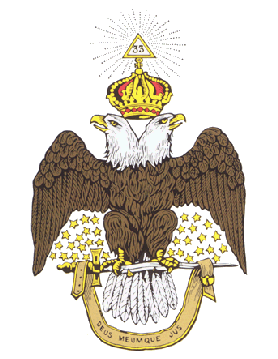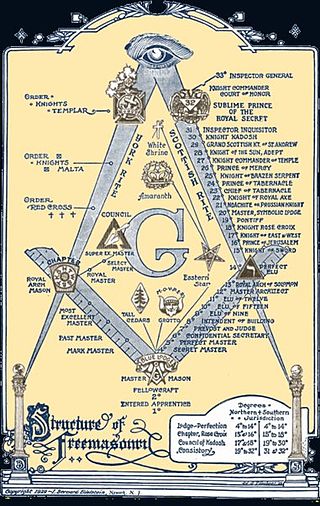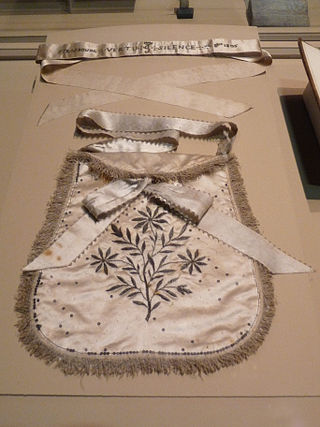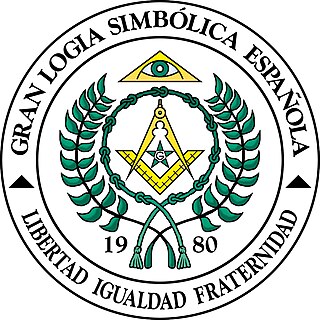
Freemasonry or Masonry refers to fraternal organisations that trace their origins to the local guilds of stonemasons that, from the end of the 14th century, regulated the qualifications of stonemasons and their interaction with authorities and clients. Modern Freemasonry broadly consists of two main recognition groups: Regular Freemasonry, which insists that a volume of scripture be open in a working lodge, that every member professes belief in a Supreme Being, that no women be admitted, and that the discussion of religion and politics do not take place within the lodge; and Continental Freemasonry, which consists of the jurisdictions that have removed some, or all, of these restrictions.

The Ancient and Accepted Scottish Rite of Freemasonry is a Rite within the broader context of Freemasonry. It is the most widely practiced Rite in the world. In some parts of the world, and in the Droit Humain, it is a concordant body and oversees all degrees from the 1st to 33rd degrees, while in other areas, a Supreme Council oversees the 4th to 33rd degrees.
The history of Freemasonry encompasses the origins, evolution and defining events of the fraternal organisation known as Freemasonry. It covers three phases. Firstly, the emergence of organised lodges of operative masons during the Middle Ages, then the admission of lay members as "accepted" or "speculative" masons, and finally the evolution of purely speculative lodges, and the emergence of Grand Lodges to govern them. The watershed in this process is generally taken to be the formation of the first Grand Lodge in London in 1717. The two difficulties facing historians are the paucity of written material, even down to the 19th century, and the misinformation generated by masons and non-masons alike from the earliest years.
In Freemasonry, regularity is one of the factors by which individual Grand Lodges judge whether to recognise one another for the purposes of allowing formal interaction at the Grand Lodge level and visitation by members of other jurisdictions. Each individual Grand Lodge determines which other Grand Lodges it considers Regular.
Co-Freemasonry is a form of Freemasonry which admits both men and women. It began in France in the 1890s with the forming of Le Droit Humain, and is now an international movement represented by several Co-Freemasonic administrations throughout the world. Most male-only Masonic Lodges do not recognise Co-Freemasonry, holding it to be irregular.

There are many organisations and orders which form part of the widespread fraternity of Freemasonry, each having its own structure and terminology. Collectively these may be referred to as Masonic bodies, Masonic orders, Concordant bodies or appendant bodies of Freemasonry.
This is a general survey on the historical and modern presence of Freemasonry in countries located in Asia.

Freemasonry has had a complex relationship with women for centuries. A few women were involved in Freemasonry before the 18th century, despite de jure prohibitions in the Premier Grand Lodge of England.
Freemasonry in Denmark was first established in 1743 and is today represented by a number of Grand Lodges. The oldest and biggest Masonic Grand Lodge in Denmark is the Danish Order of Freemasons, in English also known as the Grand Lodge of Denmark.
Continental Freemasonry, otherwise known as Liberal Freemasonry, Latin Freemasonry, and Adogmatic Freemasonry, includes the Masonic lodges, primarily on the European continent, that recognize the Grand Orient de France (GOdF) or belong to CLIPSAS, SIMPA, TRACIA **, CIMAS, COMAM, CATENA, GLUA, or any of various other international organizations of Liberal, i.e., Continental Freemasonry. The larger number of Freemasons, most of whom live in the United States–where Regular Freemasonry holds a virtual monopoly–belong to Masonic lodges that recognize the United Grand Lodge of England and do not recognize Continental Freemasons, regarding them as "irregular".
The French Rite is a Rite of Freemasonry that was founded in France, in 1786.
Freemasonry in France has been influential on the worldwide Masonic movement due to its founding of Continental Freemasonry.
Freemasonry in Belgium comprises several Masonic obediences, a federation and a confederation. These include Grand Orient of Belgium, the Grand Lodge of Belgium, the Regular Grand Lodge of Belgium, the Women's Grand Lodge of Belgium, the Belgian Federation of Le Droit Humain and Lithos Confederation of Lodges.
Continental Freemasonry in North America is relatively rare, but there are a few continental-style organizations active.
The history of Freemasonry in Belgium reflects the many influences on what is now Belgium from the neighbouring states.
Freemasonry in Germany started in several places during the second quarter of the Eighteenth century. After the extinction of the Rite of Strict Observance, which had a wide following and claimed Templar origins for its higher degrees, the several Grand Lodges in Germany defied all attempts at unification, although a largely ineffectual central organisation came into being with the unification of Germany. During the 1920s Freemasons were harassed alongside Jews by those taken in by the Protocols of the Elders of Zion, and blamed for the German surrender of 1918. This culminated with the suppression of Freemasonry by the Nazis in 1935, with many Masons in Germany and occupied countries being executed or sent to concentration camps. Freemasonry returned to Germany after World War Two. A single central body now represents five "regular" Grand Lodges. Liberal, women's, and mixed lodges also exist.
Freemasonry in Italy dates to the first half of the eighteenth century. Its success largely depended on the lack of enthusiasm with which Papal bans on the order were enforced in the various states, but after the end of the Napoleonic regime, Freemasonry was suppressed in most of the peninsula. The start of the unification process in 1859 saw a revival in Freemasonry. Giuseppe Garibaldi, a leader of Italian unification, was an active Mason and a keen supporter of the craft. In the 1920s Freemasonry was again suppressed under Fascism but revived again after the fall of Benito Mussolini. Today's Italy contains a wide variety of Masonic observances, regular, liberal, male, female and mixed.
Freemasonry in Croatia may be traced to the second half of the 18th century when it was introduced by the officers that came back from the Seven Years' War (1756–1763). However, the fraternity has been repeatedly banned and re-founded since then.

The Symbolic Grand Lodge of Spain is one of the main grand obediences in Spain. It is one of group of obediences included in CLIPSAS, and can be defined as a mixed or egalitarian, liberal and non-dogmatic Grand Lodge.
The International Masonic Association founded in 1921 and dissolved in 1950, was an international grouping of Masonic obediences. Based in Geneva, the home of the Grand Lodge Alpina of Switzerland, the international was directed along the lines of Continental Freemasonry and heavily influenced by the Grand Orient de France. The organisation was involved in political activities in Europe between the First World War and the Second World War.








